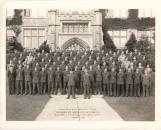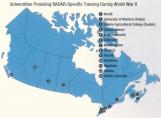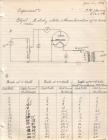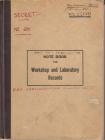1
Canada responded to Britain's urgent request for technicians and officers to maintain and operate radio stations. In October 1940 Sir Gerald Campbell, the United Kingdom's High Commissioner to Canada, asked for 100 radio officers and 1000 radio mechanics. In addition, the Royal Air Force agreed to build a training base to be located in Clinton, Ontario. The Canadians who served on radar overseas were seconded to the RAF, and were paid, supplied and supervised by the British.The first requests for recruits advertised for men familiar with radio technology, but the demand was so great that eventually more technicians were requested. By the end of the war, the recruitment and training effort exceeded six thousand personnel. The men who were recruited prior to the completion of the base in Clinton in 1941 were required to complete their training in the United Kingdom and are known as the "First of 6000".
2
The "First of 6000" were the first RCAF radar recruits who completed their training overseasCirca 1940
Toronto, Ontario, Canada
 Credits:
Credits:RCAF Photograph
The Secrets of Radar Museum Archives
3
The S.S. Leopoldville carried some of the First of 6000 overseas in 1941 -- but later sank in 1944ca. 1941
Unknown Location
 Credits:
Credits:RCAF/RAF File Photo
4
For those who followed, the first step towards becoming a radar technician, mechanic or operator was the successful completion of an intensive sixteen-week training course in electronics at one of thirteen Canadian universities. Those who performed well in the course were chosen for radar training, and were sent to Clinton for the top secret radar training.5
Graduates of the RCAF's intensive electronics training course at the University of Western OntarioCirca 1942
London, Ontario, Canada
 Credits:
Credits:RCAF Photograph
The Secrets of Radar Museum Archives
6
Thirteen Canadian universities offered a training program for RCAF recruits before going to ClintonWorld War II
 Credits:
Credits:The Secrets of Radar Museum
7
Experiment notes on diode valves from the University of Toronto training course16 June 1942
Toronto, Ontario, Canada
 Credits:
Credits:The Secrets of Radar Museum
Charles W. Young Collection
8
Timetable from the University of Toronto RCAF training course1941 to 1943
Toronto, Ontario, Canada
 Credits:
Credits:The Secrets of Radar Museum
Charles W. Young Collection
9
W/C K.R. Patrick's RDF training notebook, prior to becoming the first Canadian C/O at ClintonCirca 1941
RAF/RCAF Station Clinton, Clinton, Ontario, Canada
 Credits:
Credits:The Secrets of Radar Museum
K.R. Patrick Collection
10
Clinton Graduates in 1941Circa 1941
RAF/RCAF Station Clinton, Clinton, Ontario, Canada
 Credits:
Credits:RCAF Photograph, 1941
The Secrets of Radar Museum Archives
11
A Christmas dinner held at RCAF Clinton in 1944 kept spirits up when stationed far from home24 December 1944
 Credits:
Credits:RCAF Photograph
The Secrets of Radar Museum Archives
Edith Baker Scrapbook
12
This menu for a formal dinner at RAF Clinton in 1941 included roast turkey and potatoes16 August 1941
RAF/RCAF Station Clinton, Clinton, Ontario, Canada
 Credits:
Credits:The Secrets of Radar Museum Archives
Edith Baker Scrapbook
13
The reverse side of the menu was signed by those at the dinner, including many from the U.S. Navy16 August 1941
RAF/RCAF Station Clinton, Clinton, Ontario, Canada
 Credits:
Credits:The Secrets of Radar Museum Archives
Edith Baker Scrapbook
14
It was at RAF Clinton that the Oath of Secrecy was taken, and recruits were subjected to tight security and long hours of training.In 1943, the RCAF took command of the station and Wing Commander Kenneth R. Patrick became the first Canadian commanding officer of RCAF Clinton. RCAF Clinton continued to provide radar training until 1971, when the base closed. The location is now known as town of Vanastra, Ontario.